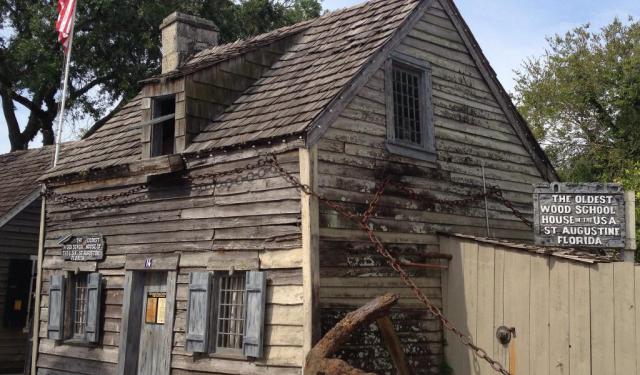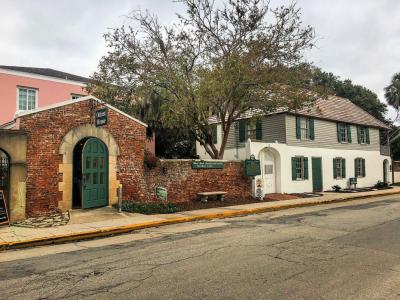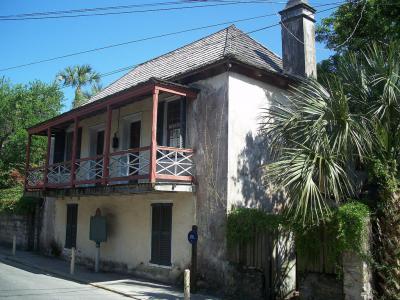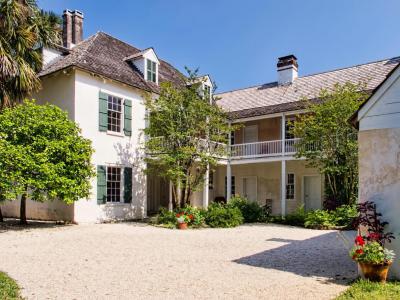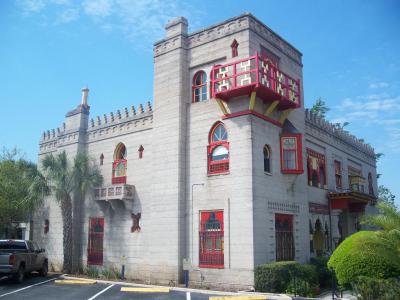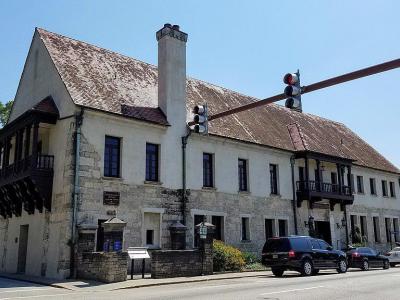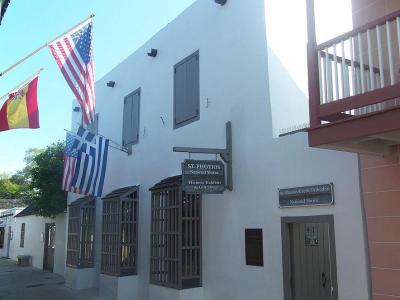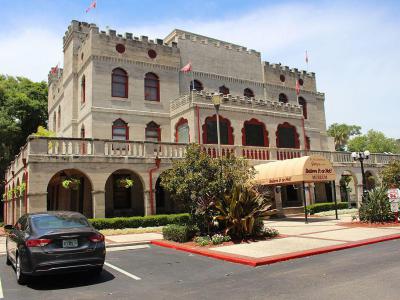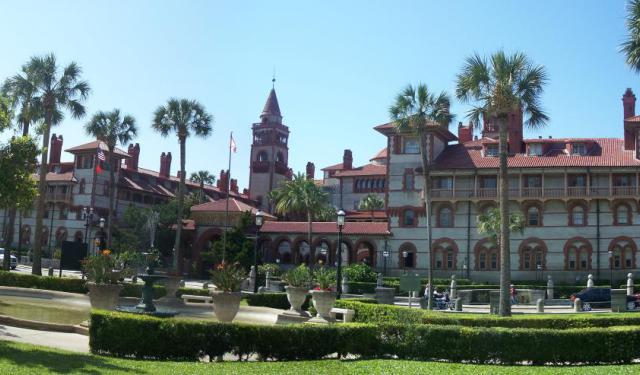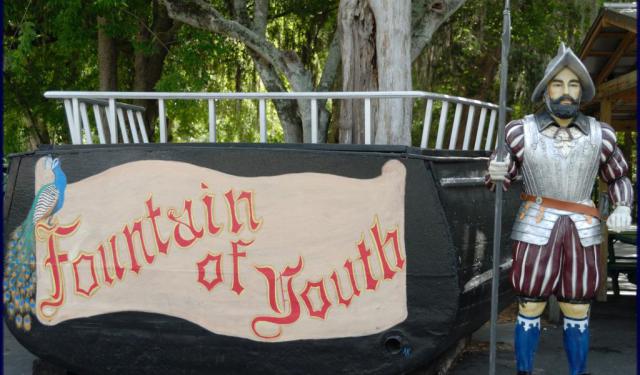St. Augustine's Historical Houses Tour (Self Guided), St. Augustine
A great deal of St. Augustine's storied past is set in stone in the form of houses that have been inhabited for over 400 years. The number of historic homes found in the city offer a glimpse into its colorful culture with European roots.
Among the most notable of them is the Ximenez-Fatio House. Built in 1798, originally as a boarding place for wealthy travelers, today this property serves as a museum showcasing the lifestyle of the people who lived here during the 19th century.
The Oldest House Museum complex lives up to its name, featuring the oldest surviving Spanish colonial dwelling in Florida, dating back as far as the 1600s. Visitors can take a tour of the property and its gardens, as well as view the exhibits about the city's history.
The Villa Zorayda, built in 1883 by a wealthy businessman who was inspired by the architecture of the Alhambra palace in Spain, nowadays houses a museum displaying artifacts from the Moorish and Spanish cultures.
Among other historic properties worth checking out are the Llambias House (one of the city's oldest surviving buildings – of 1763), the Governor's House (constructed in the early 1700s as a residence for the Spanish colonial governors of Florida – now a Cultural Center and Museum), the Avero House (an 18th-century former home of a prominent Spanish family, presently converted to a Greek Orthodox Shrine), and the Marjorie Kinnan Rawlings Home (once inhabited by the author of the Pulitzer Prize-winning novel "The Yearling").
To learn more about the people and cultures that have shaped the eventful history of St. Augustine, Florida and explore the historic houses associated with them, take this self-guided walking tour.
Among the most notable of them is the Ximenez-Fatio House. Built in 1798, originally as a boarding place for wealthy travelers, today this property serves as a museum showcasing the lifestyle of the people who lived here during the 19th century.
The Oldest House Museum complex lives up to its name, featuring the oldest surviving Spanish colonial dwelling in Florida, dating back as far as the 1600s. Visitors can take a tour of the property and its gardens, as well as view the exhibits about the city's history.
The Villa Zorayda, built in 1883 by a wealthy businessman who was inspired by the architecture of the Alhambra palace in Spain, nowadays houses a museum displaying artifacts from the Moorish and Spanish cultures.
Among other historic properties worth checking out are the Llambias House (one of the city's oldest surviving buildings – of 1763), the Governor's House (constructed in the early 1700s as a residence for the Spanish colonial governors of Florida – now a Cultural Center and Museum), the Avero House (an 18th-century former home of a prominent Spanish family, presently converted to a Greek Orthodox Shrine), and the Marjorie Kinnan Rawlings Home (once inhabited by the author of the Pulitzer Prize-winning novel "The Yearling").
To learn more about the people and cultures that have shaped the eventful history of St. Augustine, Florida and explore the historic houses associated with them, take this self-guided walking tour.
How it works: Download the app "GPSmyCity: Walks in 1K+ Cities" from Apple App Store or Google Play Store to your mobile phone or tablet. The app turns your mobile device into a personal tour guide and its built-in GPS navigation functions guide you from one tour stop to next. The app works offline, so no data plan is needed when traveling abroad.
St. Augustine's Historical Houses Tour Map
Guide Name: St. Augustine's Historical Houses Tour
Guide Location: USA » St. Augustine (See other walking tours in St. Augustine)
Guide Type: Self-guided Walking Tour (Sightseeing)
# of Attractions: 7
Tour Duration: 1 Hour(s)
Travel Distance: 2.1 Km or 1.3 Miles
Author: DanaOffice
Sight(s) Featured in This Guide:
Guide Location: USA » St. Augustine (See other walking tours in St. Augustine)
Guide Type: Self-guided Walking Tour (Sightseeing)
# of Attractions: 7
Tour Duration: 1 Hour(s)
Travel Distance: 2.1 Km or 1.3 Miles
Author: DanaOffice
Sight(s) Featured in This Guide:
- Oldest House Museum
- Llambias House
- Ximenez-Fatio House
- Villa Zorayda
- Governor's House Cultural Center and Museum
- Avero House (St. Photios Greek Orthodox National Shrine)
- Marjorie Kinnan Rawlings Home
1) Oldest House Museum
The Oldest House Museum is a historic museum operated by the Saint Augustine Historical Society. The museum is named after the González-Alvarez House, which is the oldest surviving Spanish Colonial dwelling in the state of Florida. The house has been open to visitors since 1893 and is recognized as a National Historic Landmark by the United States Department of the Interior.
The Oldest House Museum complex includes the González-Alvarez House, the Manucy Museum, and the Edwards Gallery. The Manucy Museum is named after Albert Manucy, a local historian, and displays exhibits related to the local history of Saint Augustine. The Edwards Gallery is a rotating exhibit space that showcases various collections throughout the year.
Visitors to the Oldest House Museum can take a guided tour of the historic property, which dates back to the early 1700s. In addition to the guided tour of the house, visitors can also access the Webb Museum, which is the oldest purpose-built museum in the state of Florida. The museum complex also includes ornamental gardens, the Surf Culture Museum, and a museum store.
The Oldest House Museum is open to visitors daily from 10:00 a.m. to 5:00 p.m. Tours run every half hour, and reservations are not required. The museum offers a unique opportunity to explore Florida's rich history and discover the stories of the people who once lived in the oldest surviving Spanish Colonial dwelling in the state.
The Oldest House Museum complex includes the González-Alvarez House, the Manucy Museum, and the Edwards Gallery. The Manucy Museum is named after Albert Manucy, a local historian, and displays exhibits related to the local history of Saint Augustine. The Edwards Gallery is a rotating exhibit space that showcases various collections throughout the year.
Visitors to the Oldest House Museum can take a guided tour of the historic property, which dates back to the early 1700s. In addition to the guided tour of the house, visitors can also access the Webb Museum, which is the oldest purpose-built museum in the state of Florida. The museum complex also includes ornamental gardens, the Surf Culture Museum, and a museum store.
The Oldest House Museum is open to visitors daily from 10:00 a.m. to 5:00 p.m. Tours run every half hour, and reservations are not required. The museum offers a unique opportunity to explore Florida's rich history and discover the stories of the people who once lived in the oldest surviving Spanish Colonial dwelling in the state.
2) Llambias House
The Llambias House is a remarkable example of the historic architecture of Saint Augustine. Located in a residential area south of downtown, the house is one of the few buildings in the city that dates back to the first Spanish colonial period, from 1565 to 1763. The house has been designated a National Historic Landmark due to its historic significance.
The Llambias House was restored in the 1950s and is an excellent representation of Saint Augustine's architectural style, which was first developed by the Spanish and later modified by the British during the colonial period. The house is a two-story structure built mainly out of plastered coquina limestone and covered by a dormered hip roof. The street-facing facade has two windows on the ground floor and an overhanging wood-frame balcony on the second floor. The entrance is at the center, flanked by windows on either side. The property also includes a kitchen located in an outbuilding, which is also built of coquina.
The original construction date of the Llambias House is unknown, but it was already standing when Florida was turned over to Great Britain by the Spanish in 1763. At that time, the house was a single-story structure built according to the so-called "Saint Augustine plan," a house design that the Spanish developed to deal with Florida's heat and humidity. This plan typically included an open loggia chamber at one end, but the Llambias House has a wood-frame veranda instead.
In 1777-78, the house was enlarged by Juan Andreu, who added the second floor and installed windows into previously unglazed window openings. The Llambias family acquired the house in 1854, and it remained in their family until 1919. The house was given to the city in 1954, and a major restoration was undertaken at that time.
Today, visitors can walk by the Llambias House, but it's only open by appointment and for private functions. For more information, guests can call the Saint Augustine Historical Society at (904) 824-2872.
The Llambias House was restored in the 1950s and is an excellent representation of Saint Augustine's architectural style, which was first developed by the Spanish and later modified by the British during the colonial period. The house is a two-story structure built mainly out of plastered coquina limestone and covered by a dormered hip roof. The street-facing facade has two windows on the ground floor and an overhanging wood-frame balcony on the second floor. The entrance is at the center, flanked by windows on either side. The property also includes a kitchen located in an outbuilding, which is also built of coquina.
The original construction date of the Llambias House is unknown, but it was already standing when Florida was turned over to Great Britain by the Spanish in 1763. At that time, the house was a single-story structure built according to the so-called "Saint Augustine plan," a house design that the Spanish developed to deal with Florida's heat and humidity. This plan typically included an open loggia chamber at one end, but the Llambias House has a wood-frame veranda instead.
In 1777-78, the house was enlarged by Juan Andreu, who added the second floor and installed windows into previously unglazed window openings. The Llambias family acquired the house in 1854, and it remained in their family until 1919. The house was given to the city in 1954, and a major restoration was undertaken at that time.
Today, visitors can walk by the Llambias House, but it's only open by appointment and for private functions. For more information, guests can call the Saint Augustine Historical Society at (904) 824-2872.
3) Ximenez-Fatio House
The Ximenez-Fatio House Museum is a remarkable example of Second Spanish Period residential architecture in Saint Augustine. It is considered one of the best-preserved and most authentic residential buildings from this period. The property was added to the National Register of Historic Places in 1973 and designated a Florida Heritage Landmark in 2012.
The museum complex is situated on the oldest documented street in the United States and is located in the heart of Old Town, which is the city's oldest continuously occupied community. The property was privately owned and managed by The National Society of The Colonial Dames of America in The State of Florida (NSCDA-FL) since 1939. Through their efforts, the property was restored and interpreted to reflect its function as a fashionable boarding house during Florida's first tourist boom, which began after 1821.
The Ximenez-Fatio House Museum is a historic house museum that tells the stories of the visitors who lodged there, the women who owned and managed it, and how people lived during Florida's territorial period. It is furnished and presented in a way that reflects its history and allows visitors to step back in time.
The Ximenez-Fatio House Museum is an exceptional example of Saint Augustine Plan architecture, a hybrid style that blends elements of Spanish Colonial architecture with more elegant Federal-style architecture introduced during Florida's British Period. This unique style is evident in the property's features, including its interior design, ornate moldings, and high ceilings.
Visitors to the Ximenez-Fatio House Museum will find themselves transported back in time to experience the elegance and sophistication of Florida's territorial period.
The museum complex is situated on the oldest documented street in the United States and is located in the heart of Old Town, which is the city's oldest continuously occupied community. The property was privately owned and managed by The National Society of The Colonial Dames of America in The State of Florida (NSCDA-FL) since 1939. Through their efforts, the property was restored and interpreted to reflect its function as a fashionable boarding house during Florida's first tourist boom, which began after 1821.
The Ximenez-Fatio House Museum is a historic house museum that tells the stories of the visitors who lodged there, the women who owned and managed it, and how people lived during Florida's territorial period. It is furnished and presented in a way that reflects its history and allows visitors to step back in time.
The Ximenez-Fatio House Museum is an exceptional example of Saint Augustine Plan architecture, a hybrid style that blends elements of Spanish Colonial architecture with more elegant Federal-style architecture introduced during Florida's British Period. This unique style is evident in the property's features, including its interior design, ornate moldings, and high ceilings.
Visitors to the Ximenez-Fatio House Museum will find themselves transported back in time to experience the elegance and sophistication of Florida's territorial period.
4) Villa Zorayda
Villa Zorayda, also known as the Zorayda Castle, is a unique and historic house located in Saint Augustine. It was built in 1883 by Franklin W. Smith, a wealthy Bostonian, as his winter home. The house was inspired by the 12th-century Moorish Alhambra Palace in Granada, Spain, and is a remarkable example of the Moorish Revival style of architecture. Smith named the house "Villa Zorayda" after one of the princesses in Washington Irving's Tales of the Alhambra.
The building is made using Smith's own innovative method of construction, which involved pouring concrete and crushed coquina shell. The interior of the Villa Zorayda is equally impressive, with intricate plasterwork and cast alabaster traceries inspired by those found in the Alhambra Palace. The building also features hand-painted wood panels and tiles, intricately designed fireplaces and doorways, and geometrically shaped windows and stained glass.
The Villa Zorayda Museum is still owned by the Mussallem family, who purchased the building and part of Smith's art and antique collection in 1913. The collection includes hand-pierced brass lamps from Damascus and other parts of the Middle East, Oriental rugs, sculptures, carved furniture, decorative tiles, and Egyptian artifacts. The museum also features a unique inscription in Arabic script above the front entrance, which reads, "There is no conqueror but God."
The Villa Zorayda has played an important role in the history of Saint Augustine. It set an architectural precedent during the Gilded Age and began the Moorish Spanish Revival style of architecture that is seen throughout the city.
The building is made using Smith's own innovative method of construction, which involved pouring concrete and crushed coquina shell. The interior of the Villa Zorayda is equally impressive, with intricate plasterwork and cast alabaster traceries inspired by those found in the Alhambra Palace. The building also features hand-painted wood panels and tiles, intricately designed fireplaces and doorways, and geometrically shaped windows and stained glass.
The Villa Zorayda Museum is still owned by the Mussallem family, who purchased the building and part of Smith's art and antique collection in 1913. The collection includes hand-pierced brass lamps from Damascus and other parts of the Middle East, Oriental rugs, sculptures, carved furniture, decorative tiles, and Egyptian artifacts. The museum also features a unique inscription in Arabic script above the front entrance, which reads, "There is no conqueror but God."
The Villa Zorayda has played an important role in the history of Saint Augustine. It set an architectural precedent during the Gilded Age and began the Moorish Spanish Revival style of architecture that is seen throughout the city.
5) Governor's House Cultural Center and Museum
The Governor's House Cultural Center and Museum is a historic site that has served the city since 1598. Originally known as Government House or Casa del gobierno, the building was constructed of coquina and served as the governor's official residence during the First Spanish Period (1565–1763), throughout the British Period (1763–1784), and until 1812 in the Second Spanish Period (1784–1821).
The east wing of the present building dates back to the original construction between 1706 and 1713, and during the British Period, the house was the official residence of James Grant, the British royal governor of East Florida (1764–1771). After Florida was returned to Spain by the 1783 Treaty of Paris, the governor’s residence underwent major renovation from 1785–87. The last governor to use the house was Enrique White during the Second Spanish Period, who died in 1811.
The building was in ruins by the time Florida was annexed by the United States in 1821, but was rebuilt with federal funds in 1833–34 following plans drawn up by architect Robert Mills. During the American Civil War, federal troops were headquartered in the building. In 1873, another major remodeling took place using plans by architect William M. Kimball, and through the next 60 years, the post office and customs house gradually took over more and more of the building.
The building was renovated once again in 1937 as a Works Progress Administration (WPA) project and was transferred to the State of Florida in 1966 as a public monument to be administered by the Saint Augustine Historical Restoration and Preservation Commission. Today, the ground floor of the building is open to the public as Governor’s House Cultural Center and Museum, managed by UF Historic Saint Augustine, Inc.
The east wing of the present building dates back to the original construction between 1706 and 1713, and during the British Period, the house was the official residence of James Grant, the British royal governor of East Florida (1764–1771). After Florida was returned to Spain by the 1783 Treaty of Paris, the governor’s residence underwent major renovation from 1785–87. The last governor to use the house was Enrique White during the Second Spanish Period, who died in 1811.
The building was in ruins by the time Florida was annexed by the United States in 1821, but was rebuilt with federal funds in 1833–34 following plans drawn up by architect Robert Mills. During the American Civil War, federal troops were headquartered in the building. In 1873, another major remodeling took place using plans by architect William M. Kimball, and through the next 60 years, the post office and customs house gradually took over more and more of the building.
The building was renovated once again in 1937 as a Works Progress Administration (WPA) project and was transferred to the State of Florida in 1966 as a public monument to be administered by the Saint Augustine Historical Restoration and Preservation Commission. Today, the ground floor of the building is open to the public as Governor’s House Cultural Center and Museum, managed by UF Historic Saint Augustine, Inc.
6) Avero House (St. Photios Greek Orthodox National Shrine)
The Avero House is a historic landmark dedicated to the memory of the 400 Greeks who arrived in the city in 1768. These pioneers were on their way to help settle the colony of New Smyrna, Florida, but after facing ten difficult years, the survivors sought refuge in Saint Augustine, where they gathered in the Avero House for worship. This group comprised the first permanent settlement of Greeks on the continent.
The building is locally significant as one of 30 remaining houses within the historic district that pre-date 1821. Constructed in 1749, the Avero House is a two-story rectangular block with an open loggia on the southeastern portion of the lot. The walls are made of coquina stone laid in roughly horizontal courses with lime mortar, which are plastered both inside and outside. At the flat roof, there are several copper scuppers, and one coquina masonry chimney with two flues.
The Greek Orthodox Archdiocese of North and South America purchased the building in 1966 and restored it to its 1730s appearance. Today the Avero House is open to the public as the Saint Photios Greek Orthodox National Shrine, which honors the first colony of Greek people who came to America in 1768. The Shrine includes the Saint Photios Chapel, featuring Byzantine iconography and the relics of 18 saints of the Early Church. Additionally, there is a museum with permanent exhibits about the life of early Greek settlers as well as temporary exhibits that are changed out annually.
In recognition of its historical significance, the Avero House was added to the U.S. National Register of Historic Places on June 13, 1972. Visitors to Saint Augustine can experience this important piece of Greek-American history and learn about the challenges and achievements of the first Greek settlers in America.
The building is locally significant as one of 30 remaining houses within the historic district that pre-date 1821. Constructed in 1749, the Avero House is a two-story rectangular block with an open loggia on the southeastern portion of the lot. The walls are made of coquina stone laid in roughly horizontal courses with lime mortar, which are plastered both inside and outside. At the flat roof, there are several copper scuppers, and one coquina masonry chimney with two flues.
The Greek Orthodox Archdiocese of North and South America purchased the building in 1966 and restored it to its 1730s appearance. Today the Avero House is open to the public as the Saint Photios Greek Orthodox National Shrine, which honors the first colony of Greek people who came to America in 1768. The Shrine includes the Saint Photios Chapel, featuring Byzantine iconography and the relics of 18 saints of the Early Church. Additionally, there is a museum with permanent exhibits about the life of early Greek settlers as well as temporary exhibits that are changed out annually.
In recognition of its historical significance, the Avero House was added to the U.S. National Register of Historic Places on June 13, 1972. Visitors to Saint Augustine can experience this important piece of Greek-American history and learn about the challenges and achievements of the first Greek settlers in America.
7) Marjorie Kinnan Rawlings Home
Marjorie Kinnan Rawlings Home, also known as Ripley's Believe It or Not! Museum, is located in the historic Castle Warden in Saint Augustine. The Castle Warden was built in 1887 by William G. Warden of Philadelphia as a winter escape for his family. Warden was partners with Henry Flagler and John D. Rockefeller of the Standard Oil Company. Later, the home was purchased by Norton Baskin, a wealthy hotelier, and his wife, Pulitzer Prize-winning author Marjorie Kinnan Rawlings. They converted the home into upscale hotel accommodations, which later became the site of a tragic fire that claimed the lives of two women.
The mysterious events surrounding the fire have made the Castle Warden a popular destination for paranormal investigators and ghost hunters. Visitors to Ripley's Believe It or Not! Museum can take a guided tour of the attics and backrooms of the Castle Warden, armed with EMF meters and laser light pointers, designed to detect energy around them. A 3D movie introduces guests to the story of the Castle Warden Hotel and the suspicious fire. The movie features a paranormal team called Anomaly, who set up devices to detect evidence of voices and apparitions in the museum.
The tour guides explain the story of the fire, who the two women were, and the man that is believed to have set the whole thing in motion, Mr. X. Visitors can experience paranormal events in the hotel rooms that were once occupied by the victims. Castle Warden is a four-story Moorish castle that was later purchased by the estate of Robert Ripley and turned into the first Ripley's Believe It or Not museum. The museum features a variety of odd and unusual items from around the world, including a mummified cat, a 1⁄12 scale model of the original Ferris wheel made out of erector sets, life and death masks of famous celebrities, and shamanistic apparati from cultures around the world.
Despite its strange and spooky history, Marjorie Kinnan Rawlings Home/Ripley's Believe It or Not! Museum is a popular tourist destination in Saint Augustine. It is the oldest Ripley's Believe It or Not! museum and has been the site of many paranormal investigations.
The mysterious events surrounding the fire have made the Castle Warden a popular destination for paranormal investigators and ghost hunters. Visitors to Ripley's Believe It or Not! Museum can take a guided tour of the attics and backrooms of the Castle Warden, armed with EMF meters and laser light pointers, designed to detect energy around them. A 3D movie introduces guests to the story of the Castle Warden Hotel and the suspicious fire. The movie features a paranormal team called Anomaly, who set up devices to detect evidence of voices and apparitions in the museum.
The tour guides explain the story of the fire, who the two women were, and the man that is believed to have set the whole thing in motion, Mr. X. Visitors can experience paranormal events in the hotel rooms that were once occupied by the victims. Castle Warden is a four-story Moorish castle that was later purchased by the estate of Robert Ripley and turned into the first Ripley's Believe It or Not museum. The museum features a variety of odd and unusual items from around the world, including a mummified cat, a 1⁄12 scale model of the original Ferris wheel made out of erector sets, life and death masks of famous celebrities, and shamanistic apparati from cultures around the world.
Despite its strange and spooky history, Marjorie Kinnan Rawlings Home/Ripley's Believe It or Not! Museum is a popular tourist destination in Saint Augustine. It is the oldest Ripley's Believe It or Not! museum and has been the site of many paranormal investigations.
Walking Tours in St. Augustine, Florida
Create Your Own Walk in St. Augustine
Creating your own self-guided walk in St. Augustine is easy and fun. Choose the city attractions that you want to see and a walk route map will be created just for you. You can even set your hotel as the start point of the walk.
St. Augustine Introduction Walking Tour
It is said that the first-ever Thanksgiving meal took place in 1565, when Spanish explorers led by Pedro Menéndez held a Catholic Mass and a communal meal with the Timucua people in what is now St. Augustine, Florida.
Poised on Florida’s northeastern coast, the city holds the distinction of being the oldest continuously inhabited European-founded settlement in the United States. Its story... view more
Tour Duration: 2 Hour(s)
Travel Distance: 2.5 Km or 1.6 Miles
Poised on Florida’s northeastern coast, the city holds the distinction of being the oldest continuously inhabited European-founded settlement in the United States. Its story... view more
Tour Duration: 2 Hour(s)
Travel Distance: 2.5 Km or 1.6 Miles
St. Augustine Early Settlements Tour
The city of St. Augustine on the northeastern coast of Florida is considered the oldest continuously occupied European settlement in the United States. It was founded by Spanish explorer Don Pedro Menendez de Aviles on September 8, 1565, and served as the capital of Spanish Florida for more than 200 years.
One of the most significant early European sites in the city is the Castillo de San... view more
Tour Duration: 1 Hour(s)
Travel Distance: 2.1 Km or 1.3 Miles
One of the most significant early European sites in the city is the Castillo de San... view more
Tour Duration: 1 Hour(s)
Travel Distance: 2.1 Km or 1.3 Miles
The Most Popular Cities
/ view all
